Testing
high-efficiency midrange
drivers
Copyright 2020 © Troels Gravesen
For the
Faital 3WC-15 I was searching for a midrange driver
bigger than the magnificent
Faital 6RS140, which fits the 12" Faital so
well. Here, going with a 15" bass driver, I wanted to explore more
options and went through all data sheets from Faital, 18 SOUND, B&C,
BMS, and Ciare. BMS only has one 8" driver and based on specs, didn't
look too interesting. Ciare neither.
So, I ordered six pairs of different drivers from B&C, Faital and 18
SOUND to find out how they perform technically - and how they sound.
I was primarily looking for an even midrange frequency response with no surround resonances and an even response with a smooth roll-off above 4-5 kHz as any serious break-up modes usually calls for extensive equalisation. So, four 8" drivers and two 6" drivers, the latter being 18 SOUND 6ND410 and B&C 6PEV13-8. 6PEV13-8 reminding me of some venerable drivers from Audax in the 80'ies, the MHD17HR-NNN (found with various magnet size), which was a special, very high efficiency midrange driver - not a thing too common in those days. I've found it used with a high-efficiency 10-12" bass driver from an Onken cabinet. The yellow glass fiber Focal inverted dome was a typical companion.
The typical PA smaller midrange driver features fabric surround, large magnets, light-weight paper cones, high Fs and not least, high efficiency like 94-98 dB/2.8V/1 meter. The midrange driver in my TL-1 and TL-2 makes some 97-98 dB sensitivity - but this is a 10" driver. Size matters - as always.
How these drivers perform on a relative large baffle can be seen below. How they actually sound is another matter, and for this I mounted the drivers on a suitable baffle and equalised them as flat as possible with a single series coil and heard them like full-range drivers.
DRIVERS
Click images to view large
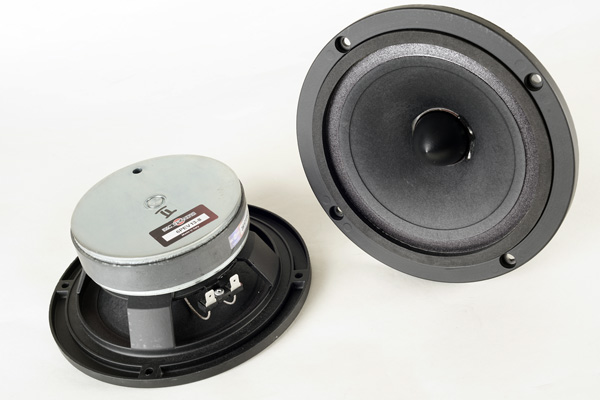
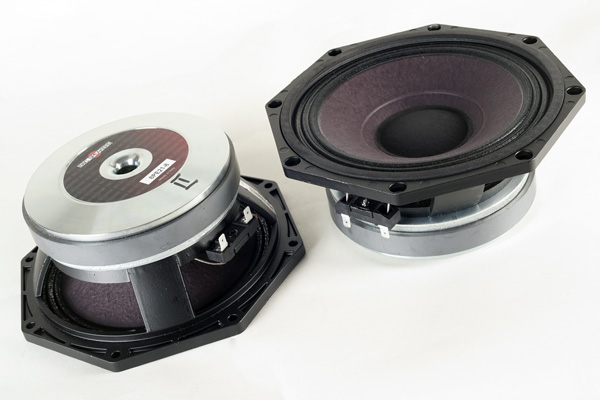
Left: B&C 6PEV-13-8. Right: B&C 8PE21-8. Both 8 Ohms.
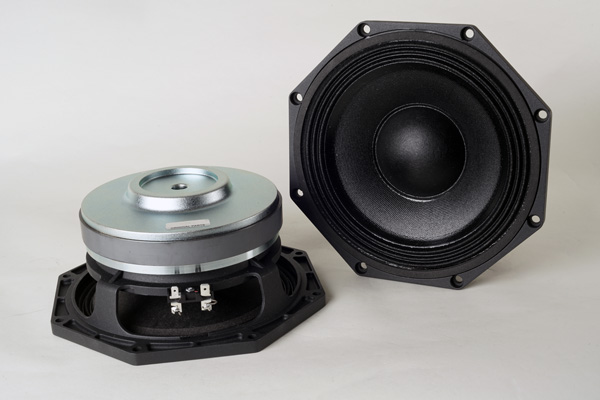
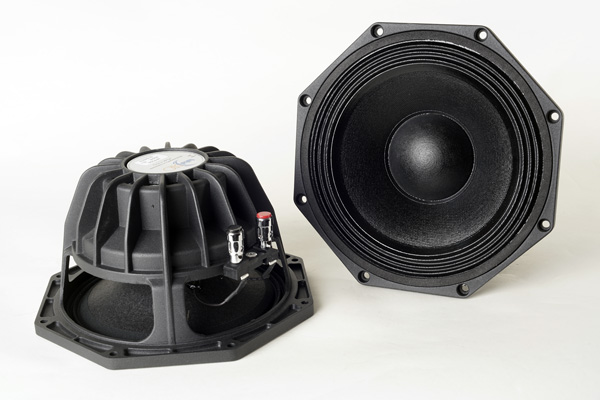
Left: Faital 8PR210 (16 Ohms). Right: Faital 8PR200 (8 Ohms).
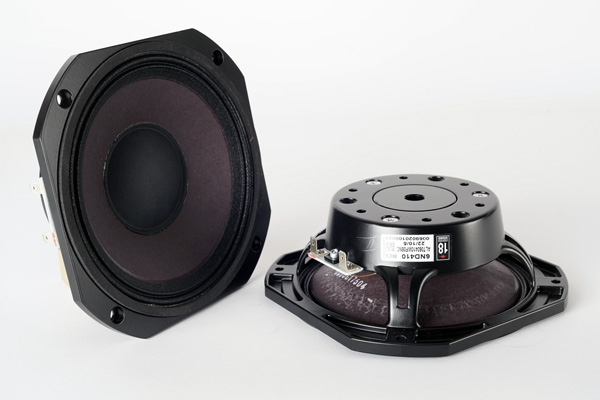
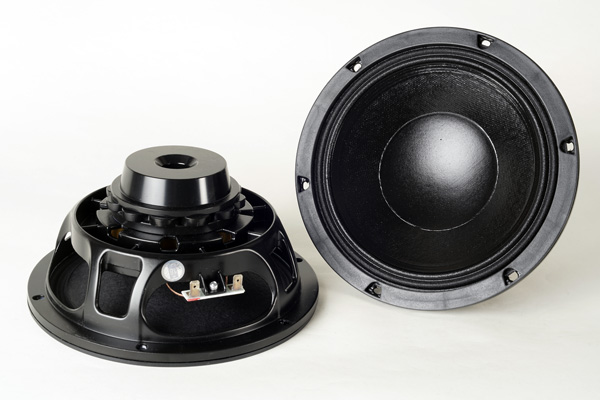
18 SOUND 6ND410 left and 8NMB420 to the right. Both 8 Ohms.
Download specs here:
B&C 6PEV-13-8 B&C 8PE21-8 Faital 8PR210-16 Faital 8PR200-8
18 SOUND 6ND410 18 SOUND 8NMB420-8
Measurements
B&C 6PEV13-8 Ohm

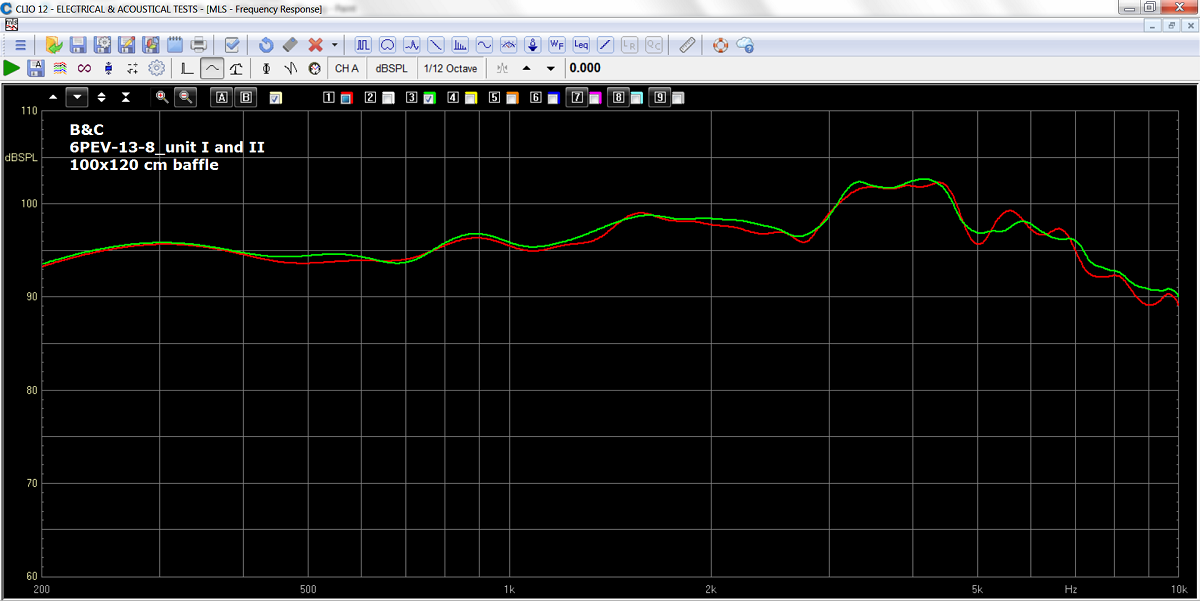
Above the frequency response of the two B&C 6PEV13-8 drivers flush
mounted on a 100 x 120 cm baffle. These drivers were not my immediate
favourites for mating a 15" bass driver, but you can never tell if you
haven't tried. Quite a nice response albeit minor bump around 3-4 kHz,
which is likely to demand some equalisation when mated with a
tweeter.
What is often the case with PA drivers featuring fabric surrounds, or
like here, a flat coated foam surround, is the lack of the all too
typical resonance issues of drivers having the usual rubber surround.
This driver have a nice response in the critical 800-2000 Hz area, where
any disturbances and phase irregularities has a profound effect on
sound. Read
here
some comments on this topic.
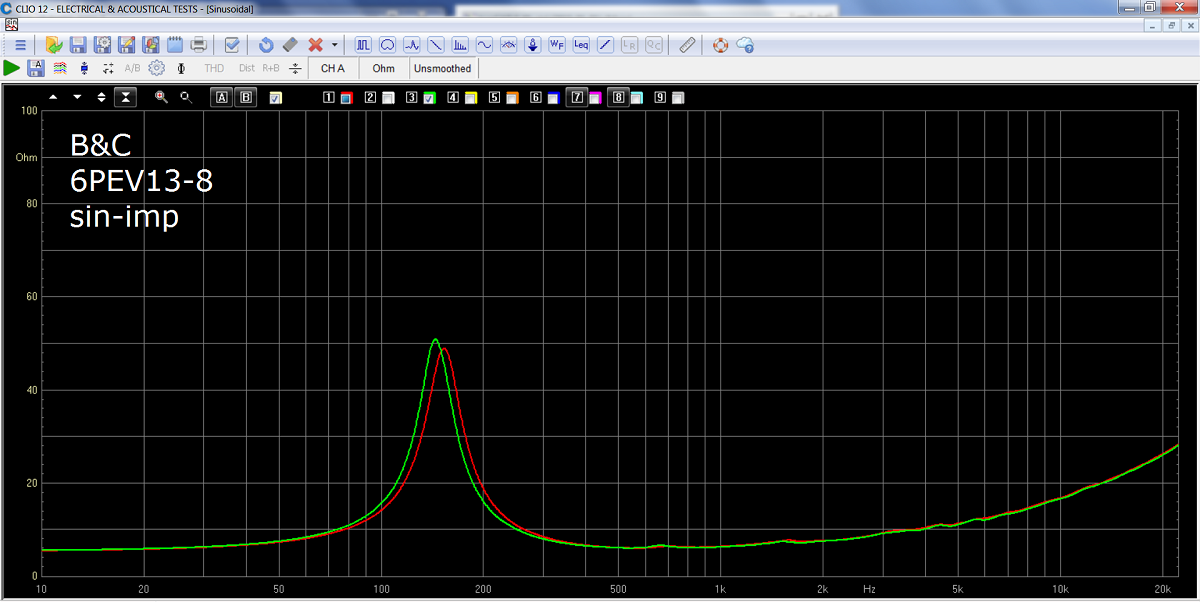
Impedance of B&C 6PEV13-8 drivers. Quite nice with very little sign of
resonances.
Using a midrange driver like this in a 3-way we are likely to liniarise
the impedance to make a proper high-pass filter.
The impedance peak is not as high as expected, but then again B&C
promises a Qm of 4.6, quite high and promising very low mechanical loss.
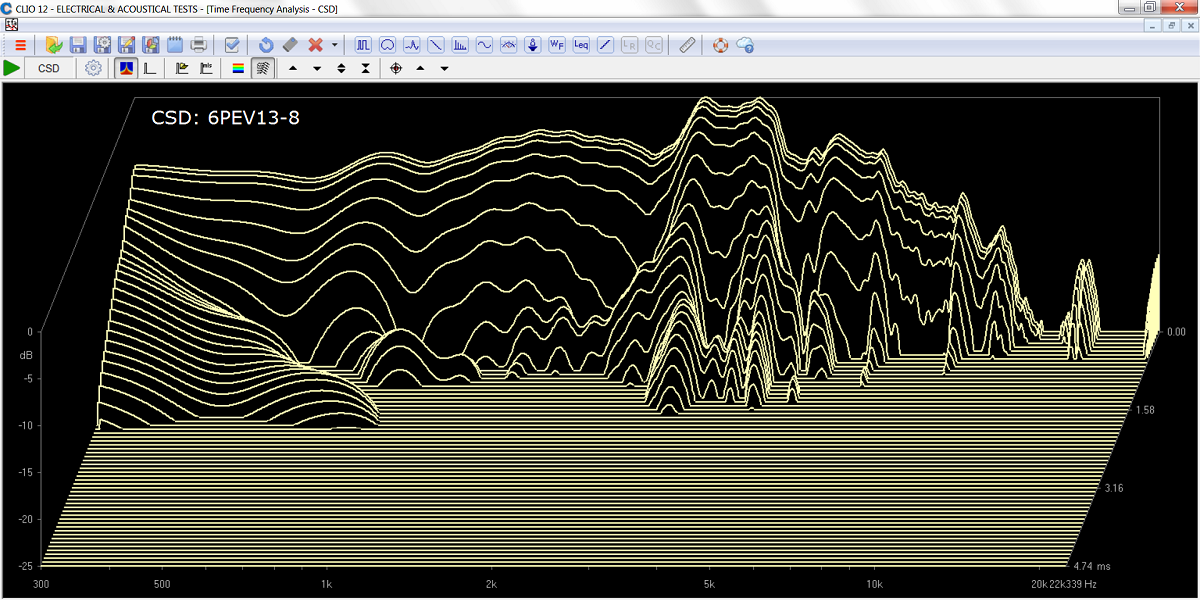
Cumulative spectral decay is interesting here to see what the 3-5 kHz
bump looks like.
This wouldn't worry me too much as it dies out fast. The bump may be
caused by the cone geometry or the phase plug, who knows.
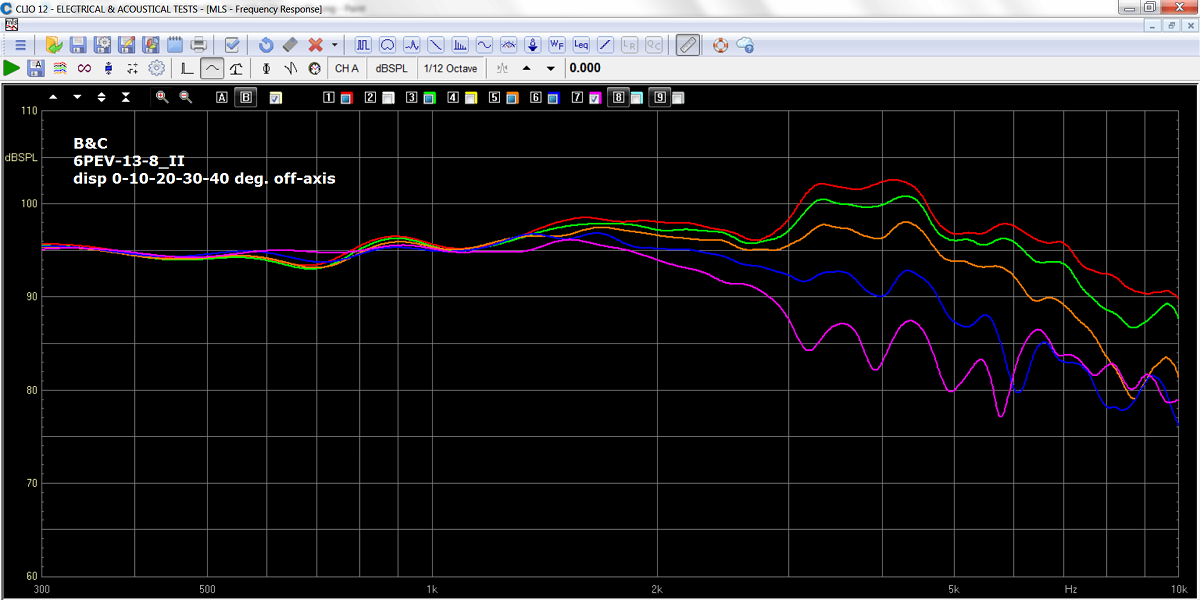
In terms of dispersion at 0, 10, 20, 30 and 40 deg. off-axis the
6PEV13-8 does really well.
This driver might well do with a point of crossover as high as 3 kHz.
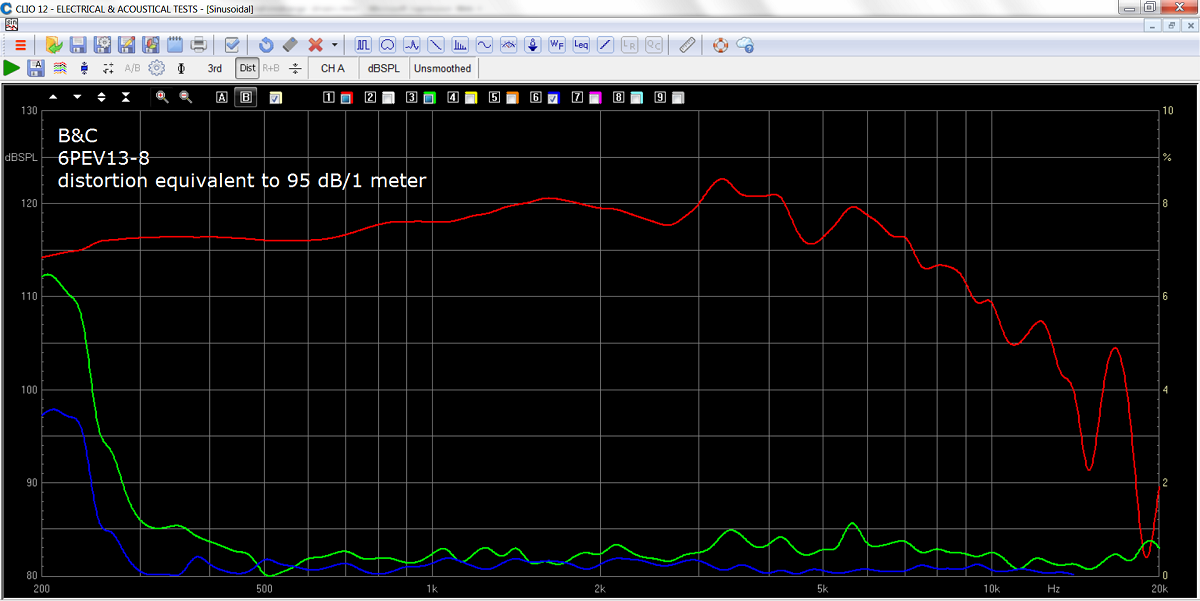
Distortion measured at a sound pressure equivalent to 95 dB/1 meter.
Green = 2nd harm., blue = 3rd harm.
Below 300 Hz the room starts interfering due to reflections.
This 6" driver could well have been used in my Faital 3WC speaker - with a different crossover that is. Overall respectable performance and quite a matched pair.
B&C 8PE21-8 Ohm

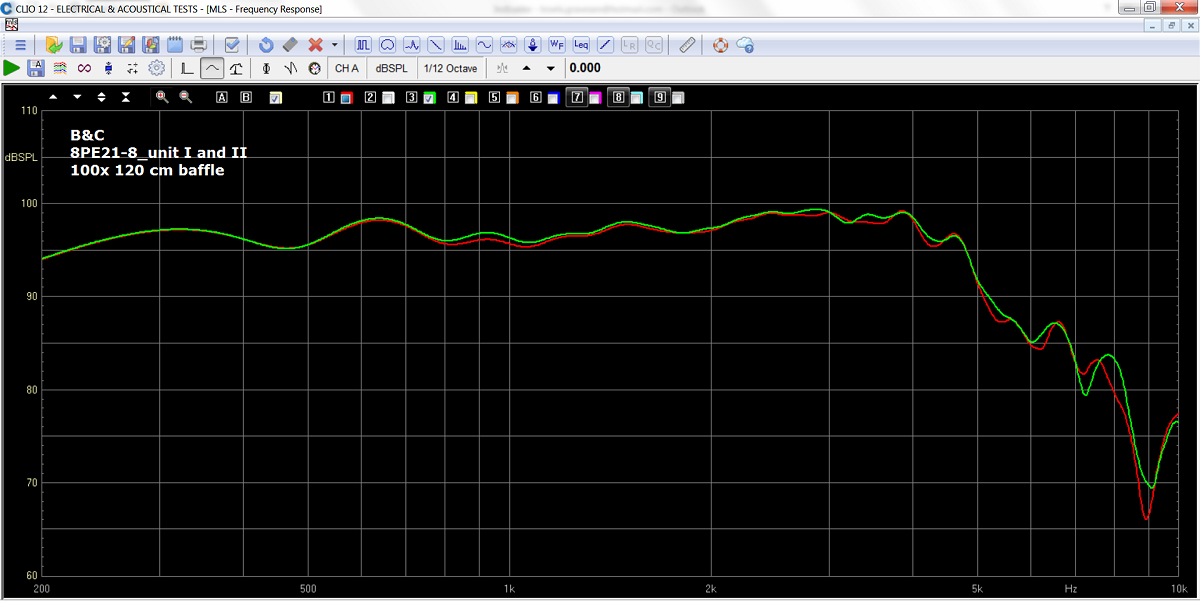
Frequency response of the two B&C 8PE21-8 drivers.
I was very pleased to see these graphs. Smooth upper-mid and a roll-off
as good as one can hope for. Very easy on crossovers.
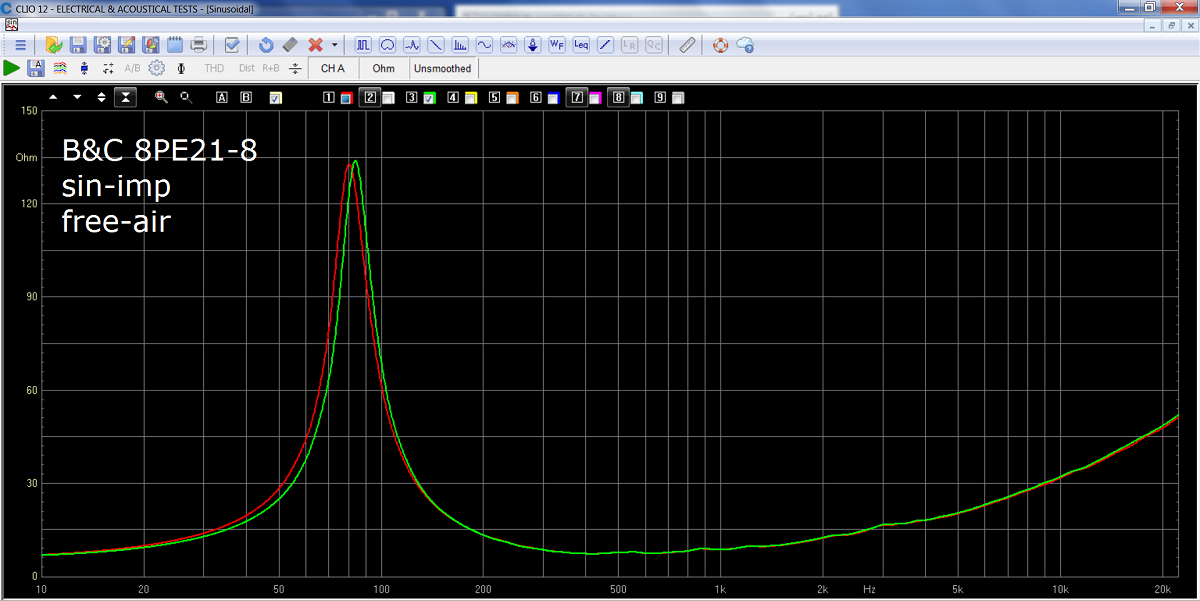
Impedance of the two drivers and well, this goes to 140 Ohms despite Qm
"only" 3.8.
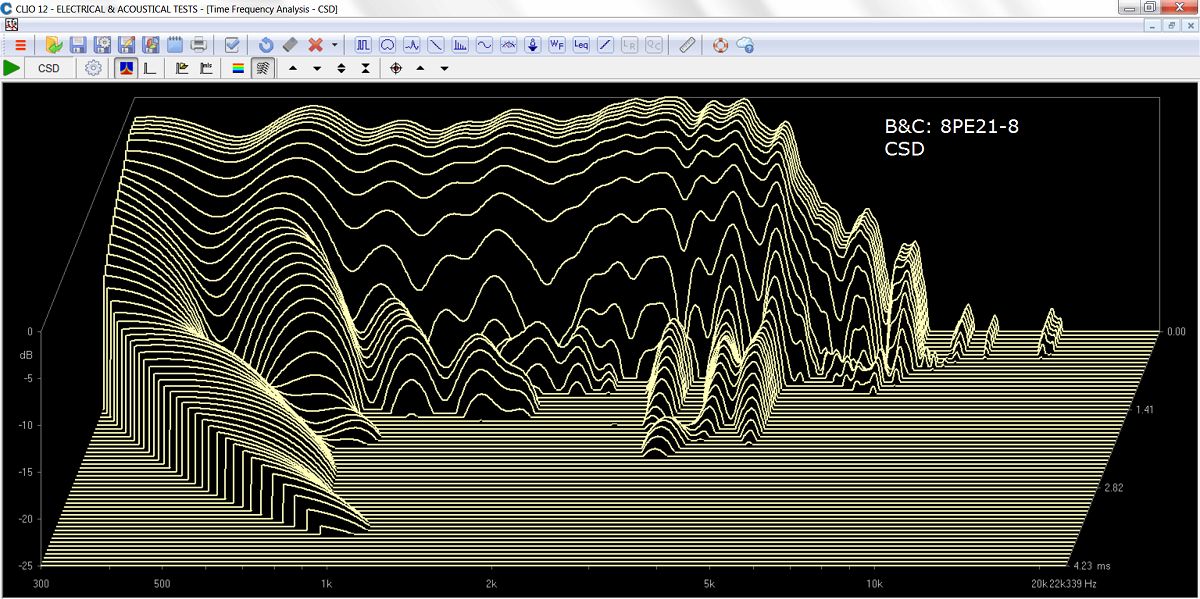
CSD looks very clean as well.
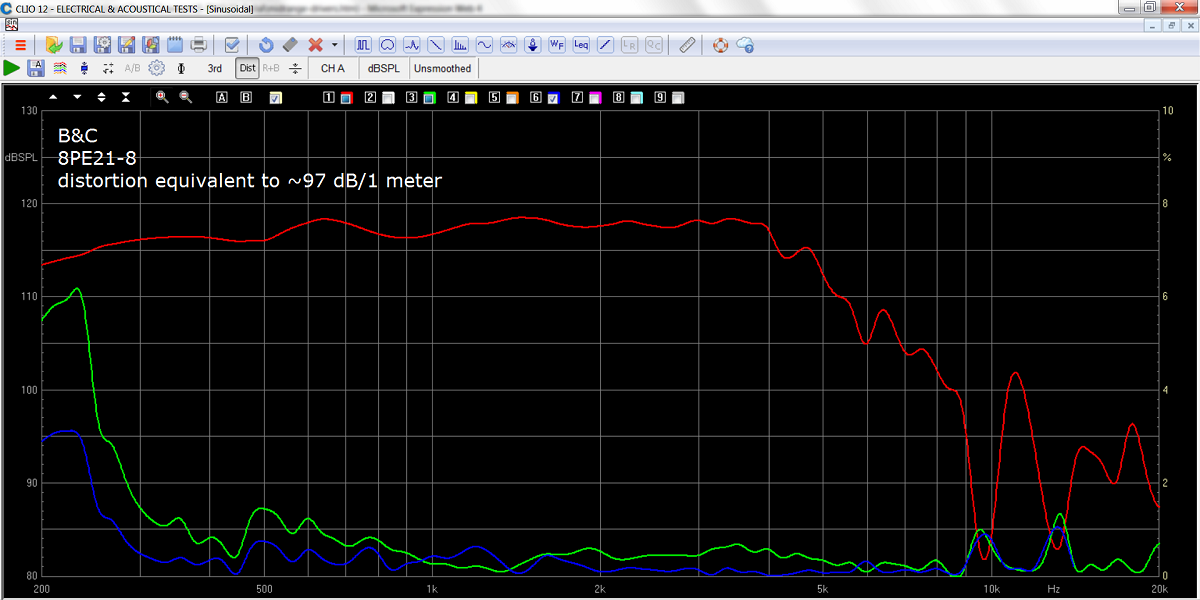
Distortion measurement of 8PE21-8. Nothing to worry about here as we're
here talking some 97 dB/1 meter.
Overall the B&C 8PE21-8 was as good as I had hoped for, so a serious
candidate for the Faital-3WC-15 construction.
Faital 8PR210-16 Ohm

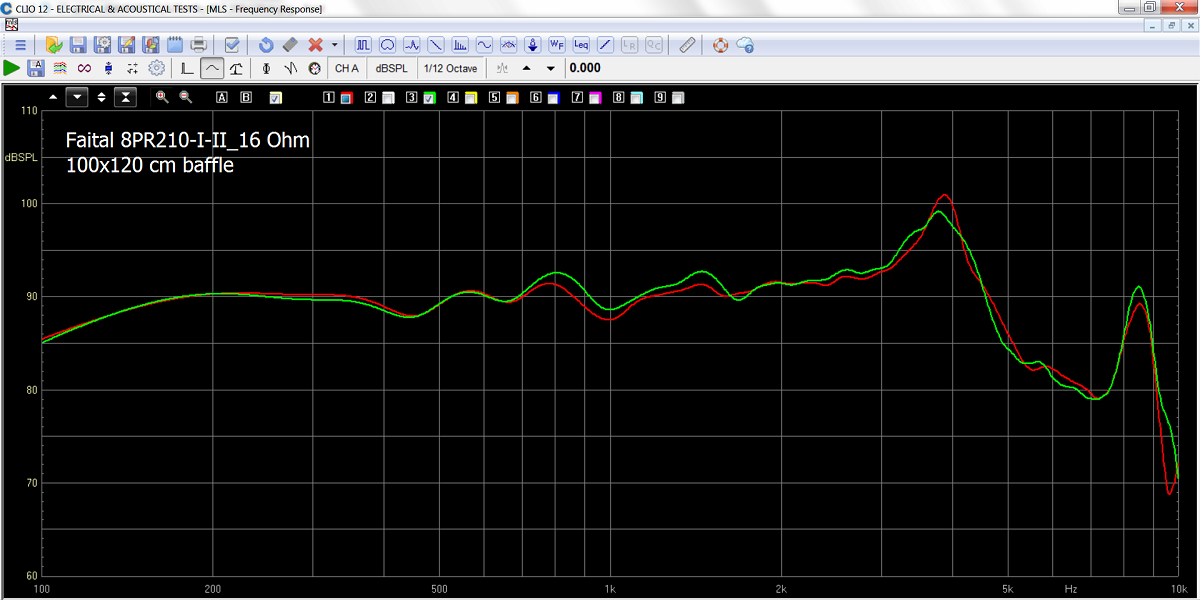
This 16 Ohm drivers should do well in some 92-94 dB systems helped by
the bass driver and tweeter from 2nd order filters.
Some inconsistency in the 700-2000 Hz range, but otherwise not too bad a
frequency response. The peak at 4 kHz may need some attention.
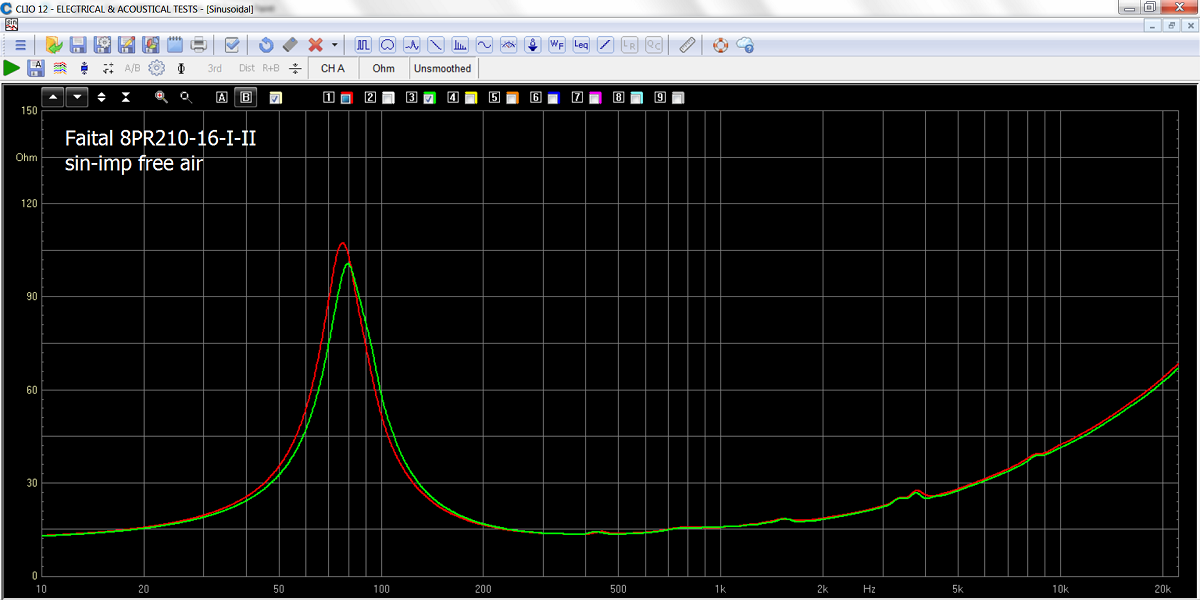
8PR210-16 impedance of the two units in free air.
As can be seen, the
impedance hardly goes below 10 Ohms.
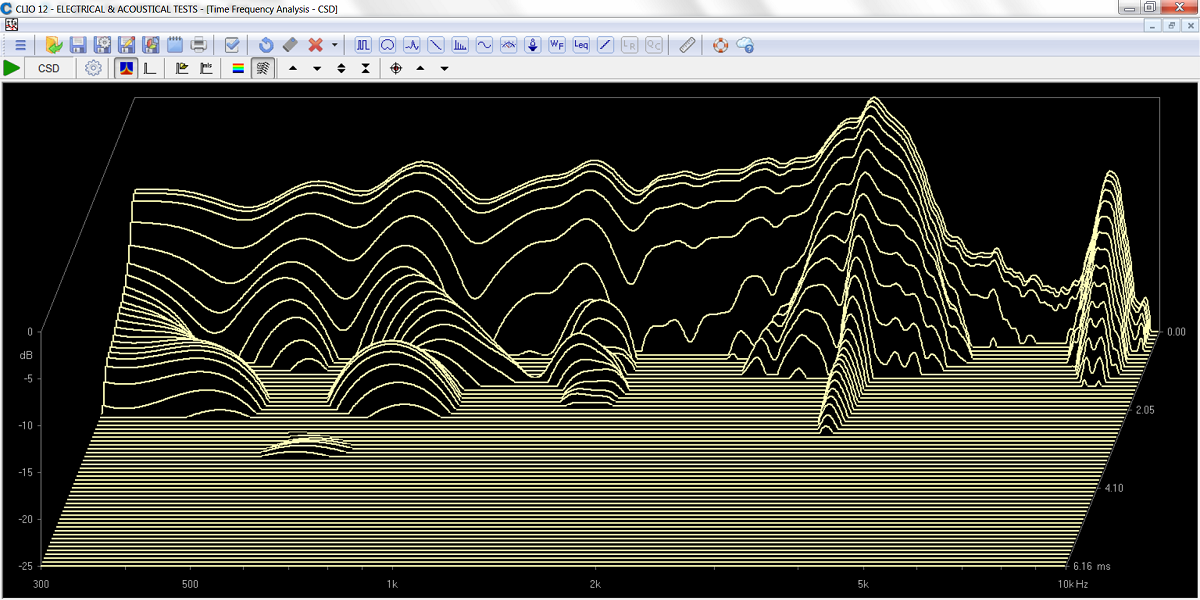
Also the waterfall plot looks promising.
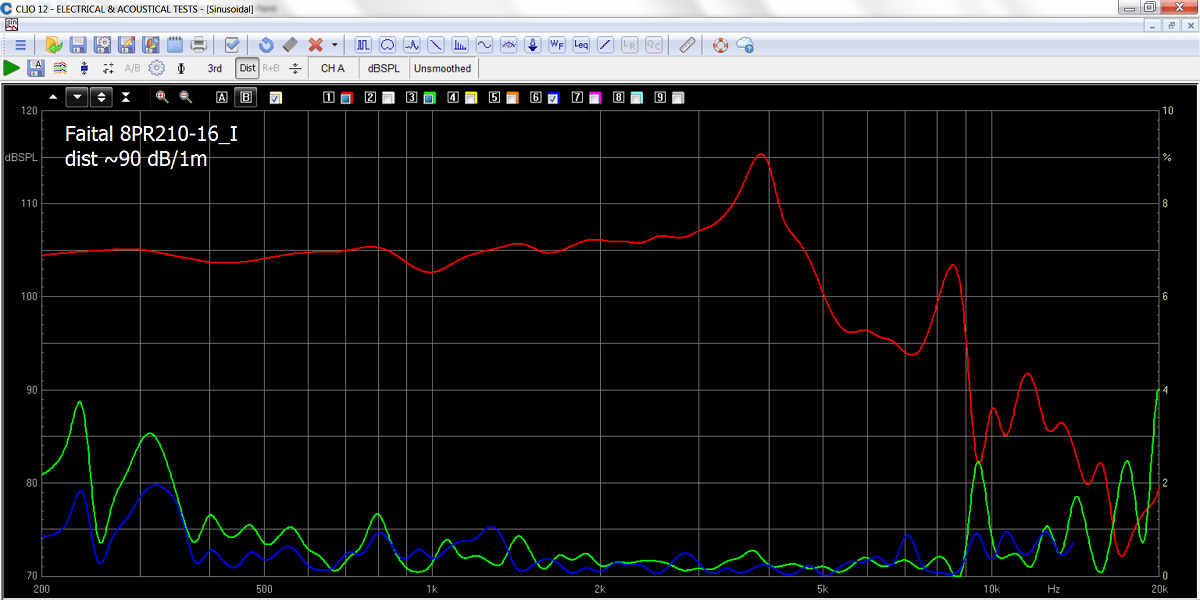
Distortion of unit I, well below 1% in all of it intended range at a
sound level around 90 dB/1 meter.

Same as above for unit II. Very similar results.
Faital 8PR200-8 Ohm

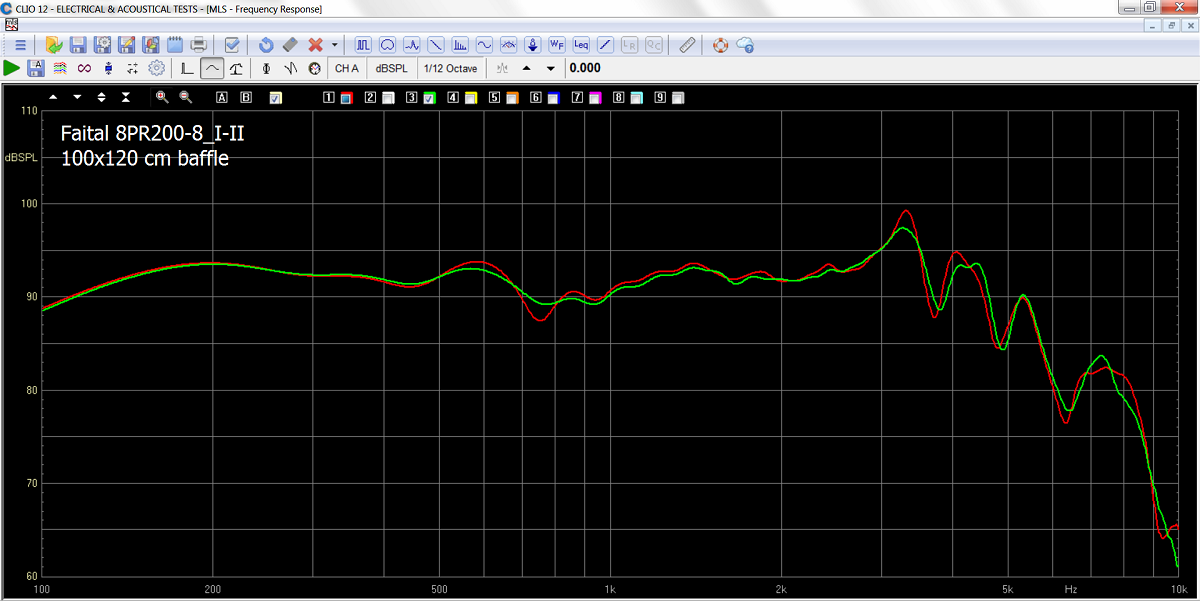
The Faital 8PR200 with a healthy 92-93 dB sensitivity and an overall
reasonably smooth response, although some difference in the 500-1000 Hz
range.
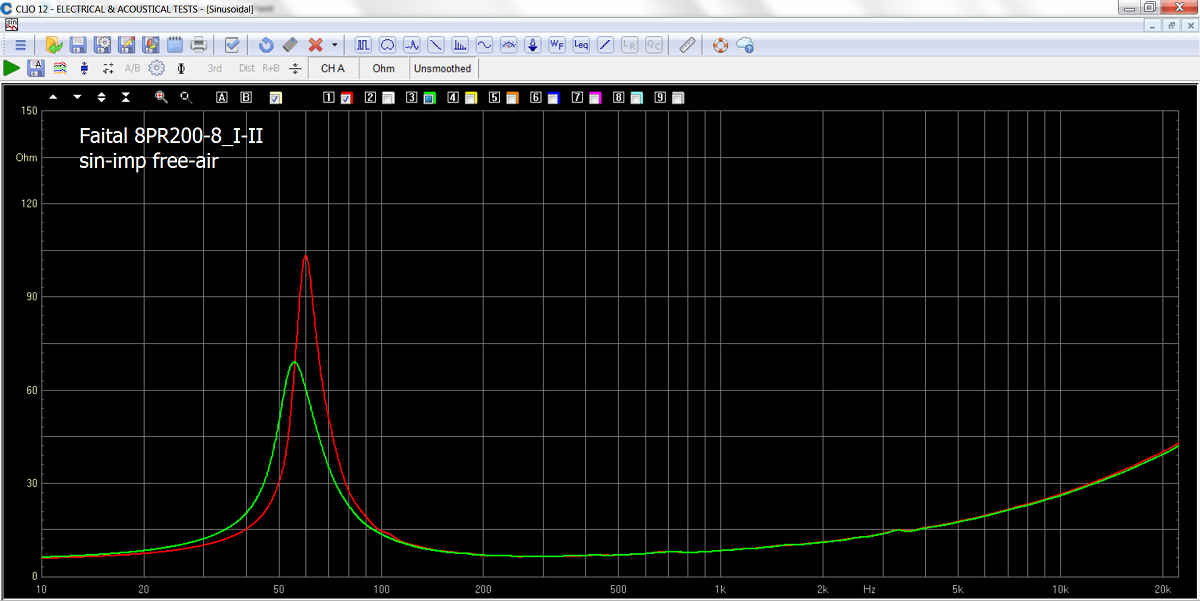
Free air impedance show quite some difference in performance (red = unit
I, green = unit II).
These midrange drivers have quite a low Fs compared to other PA midrange
drivers.
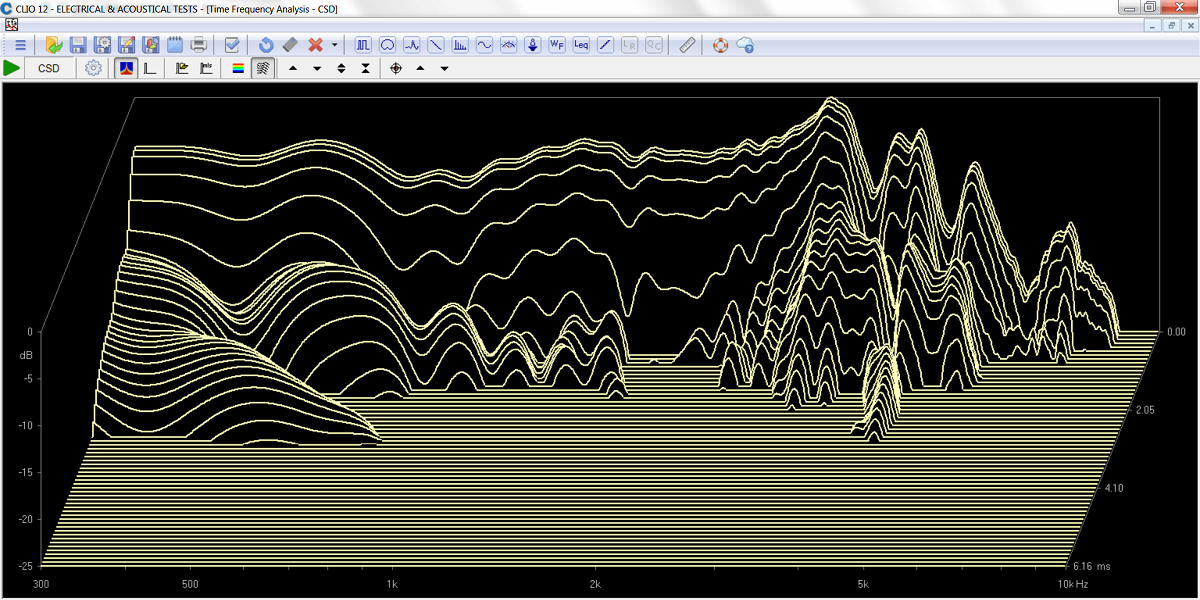
Waterfall plot looks pretty good with only minor stored energy in the
middle treble range.
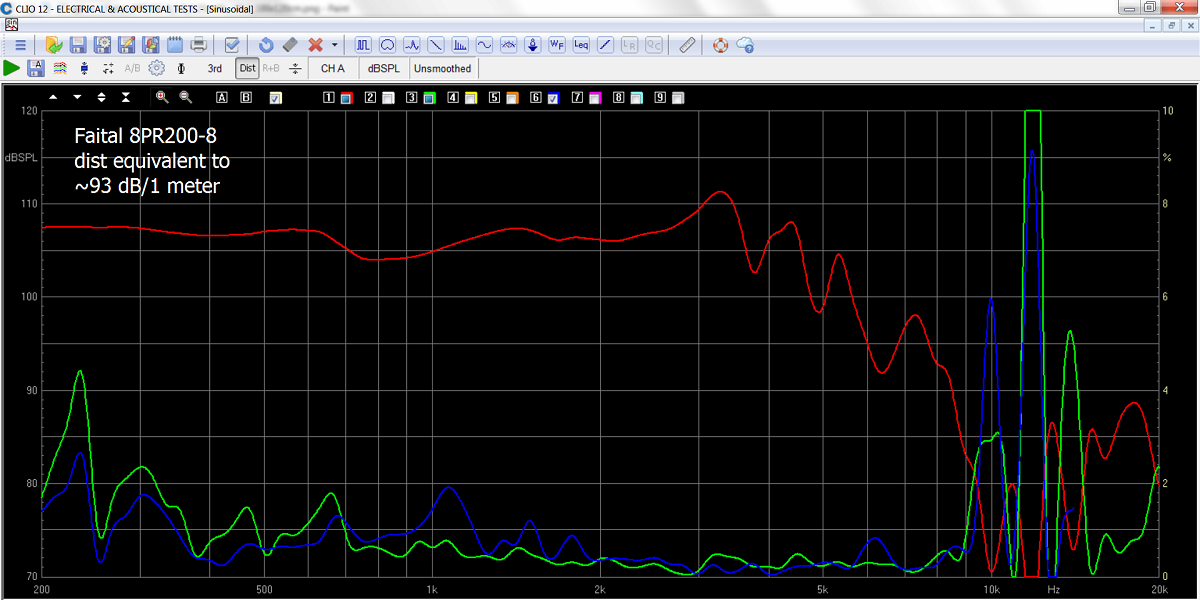
Distortion from unit I.
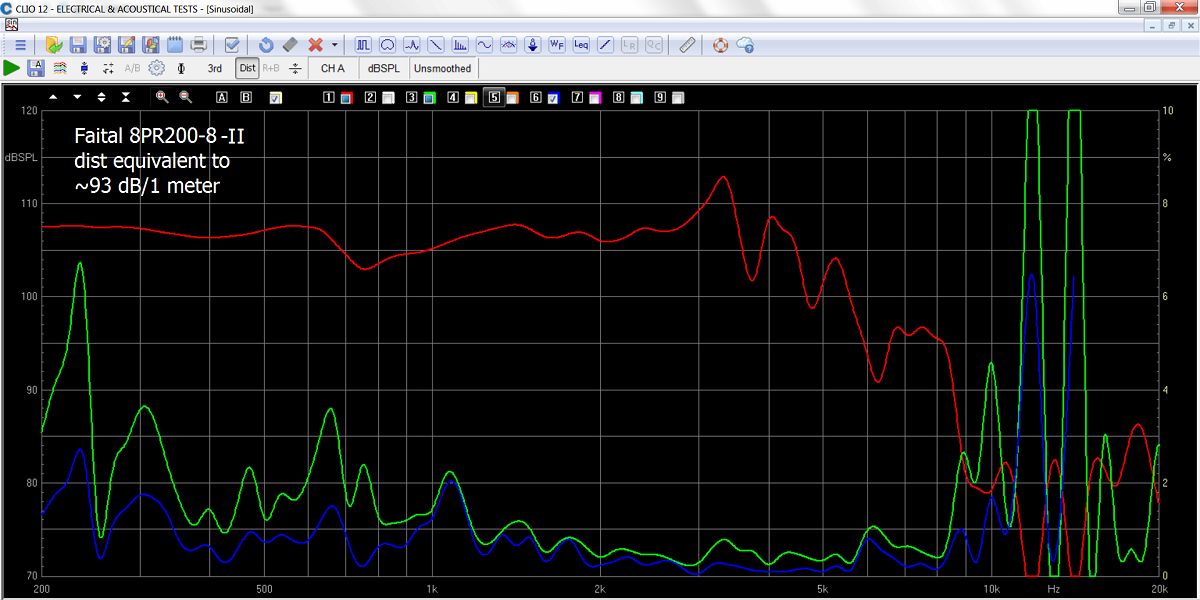
Distortion from unit II. These two drivers are not exactly a matched
pair.
18 SOUND 6ND410-8 Ohm
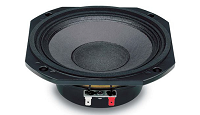
Above what is promised on the 18 SOUND data sheet. Looks nice and
suitable for quite a range when equalised to some 93-95 dB sensitivity.
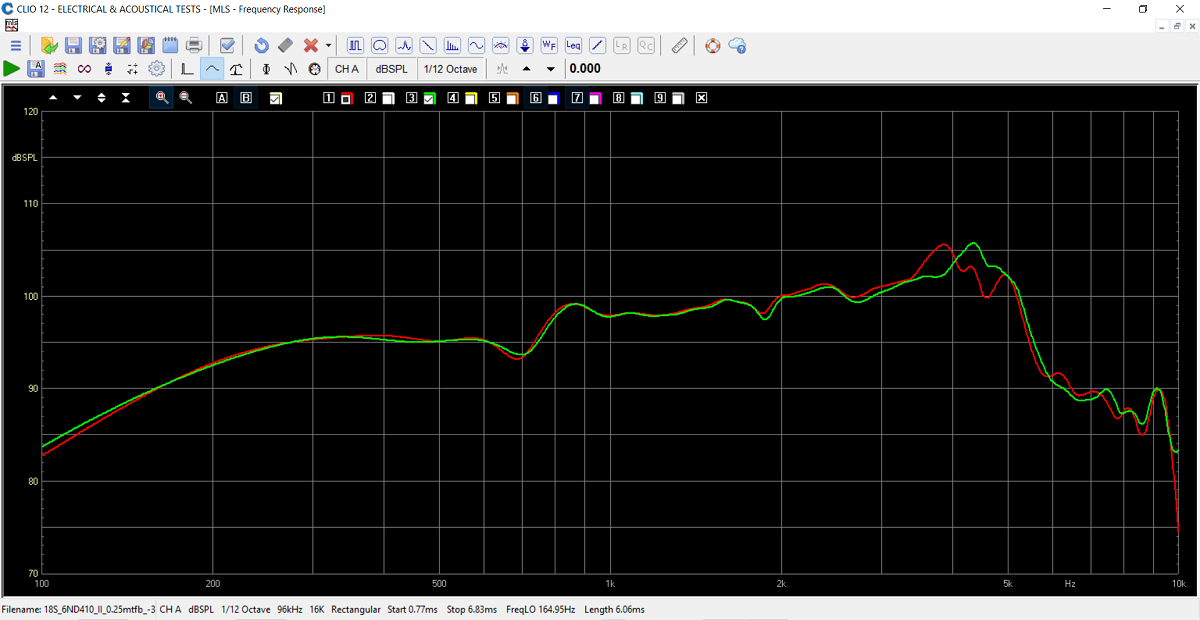
What I found on my 100x120 cm baffle very disappointing. A major shift
in response around 700 Hz, likely to impact sound noticeable due to the
phase shift.
And some peaking at 4 kHz as well. I think 18 SOUND needs to update
their data sheet.
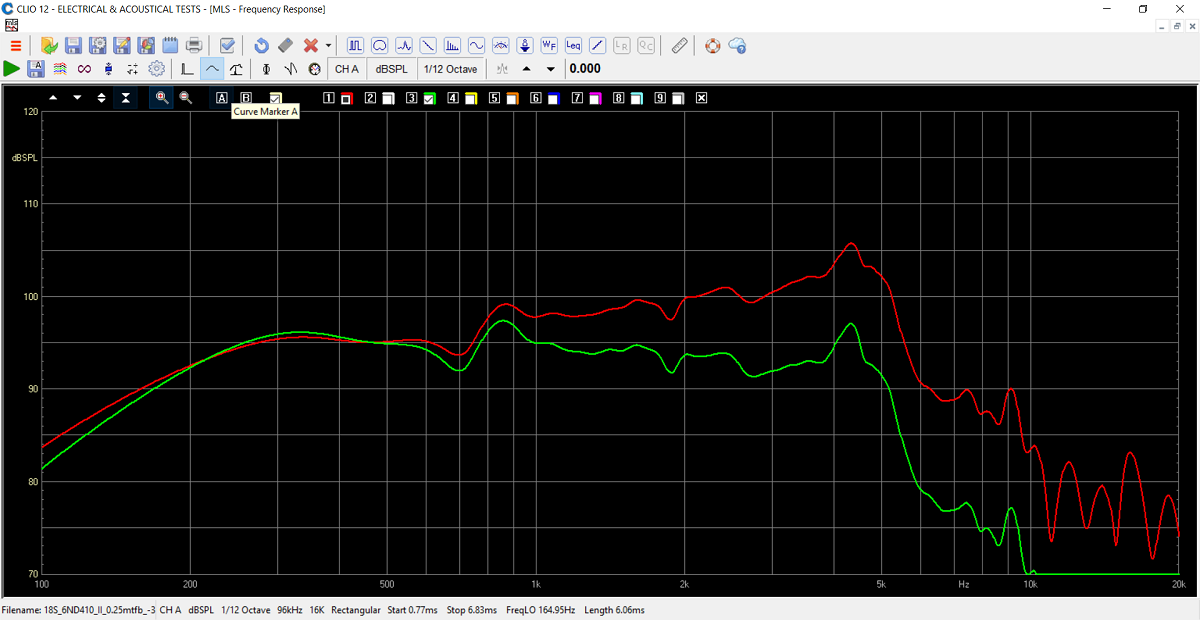
Same w/wo 1 mH coil in series (green).
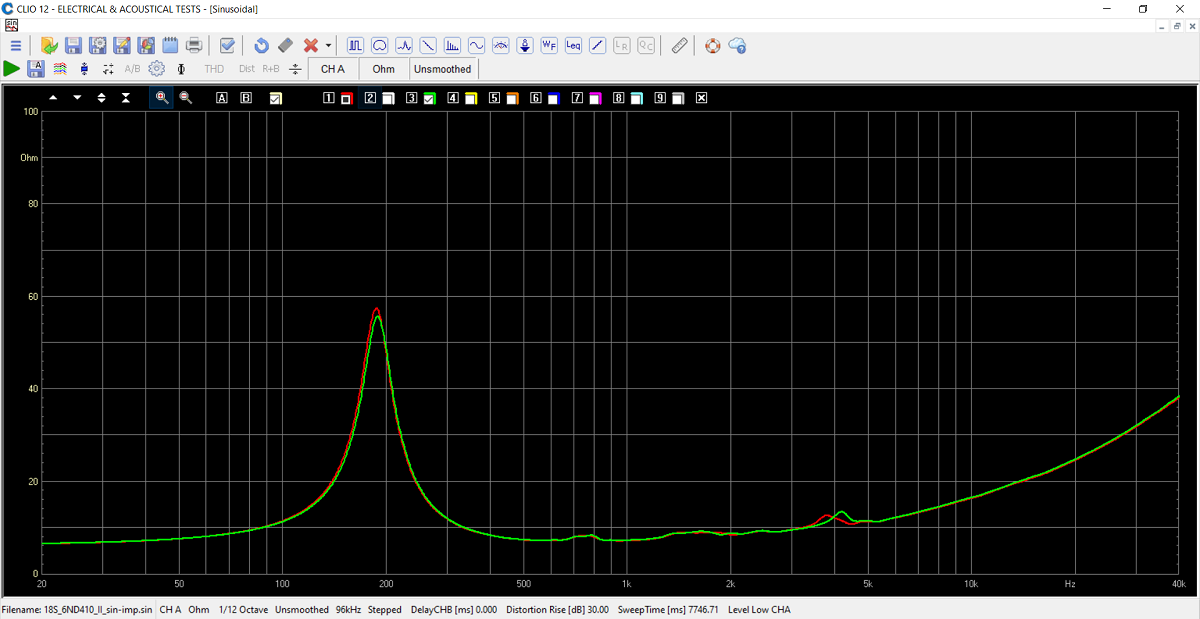
Impedance of the two drivers in free air. Some disturbances around
700-800 Hz, 1500 Hz and 3800 Hz.
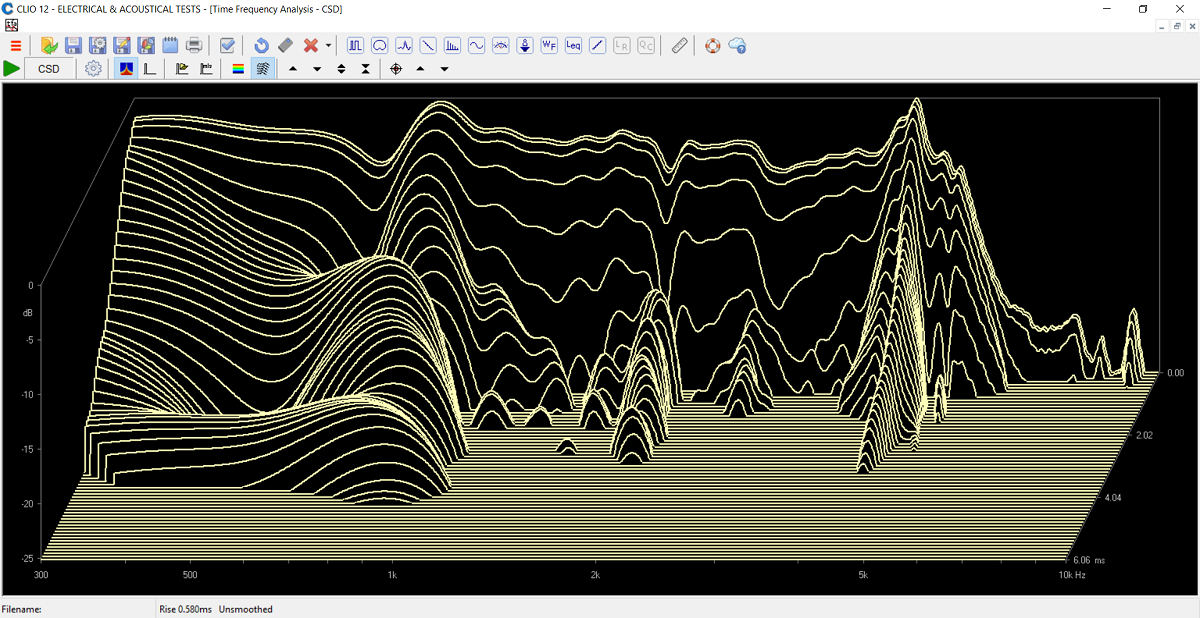
CSD from the measurement with 1 mH coil in series.
Rather disappointing result from the 6ND410 drivers.
18 SOUND 8NMB420-8 Ohm

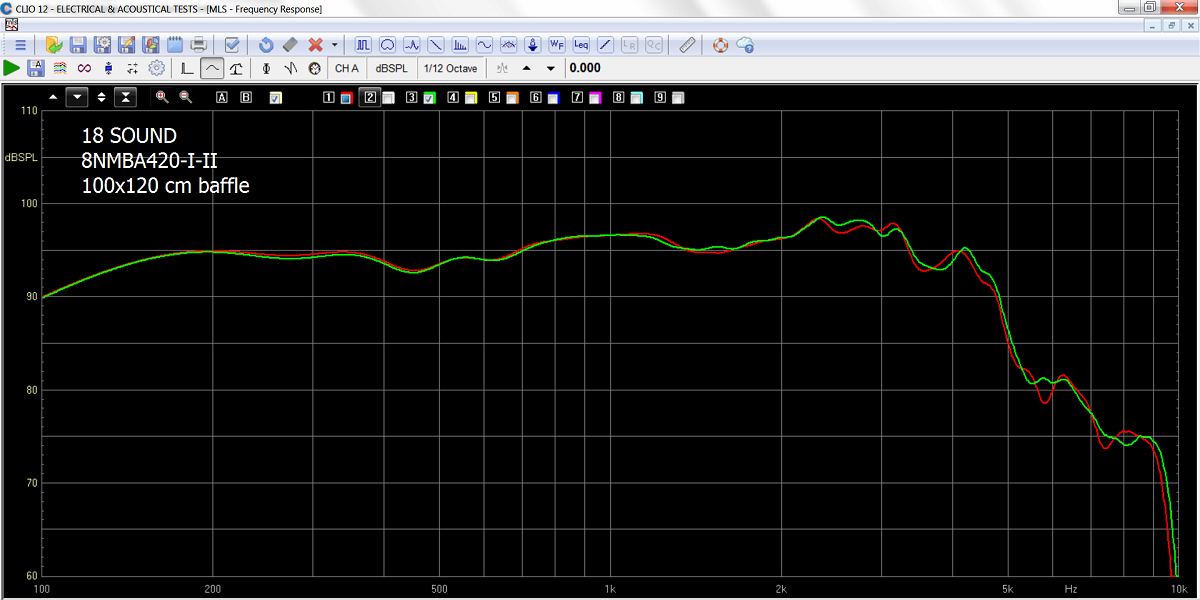
As expected, a smooth response from 18 SOUND 8NMB420. Well in accordance
with the data sheet graph.
Very little disturbance in the 2-5 kHz range, which is all too common.
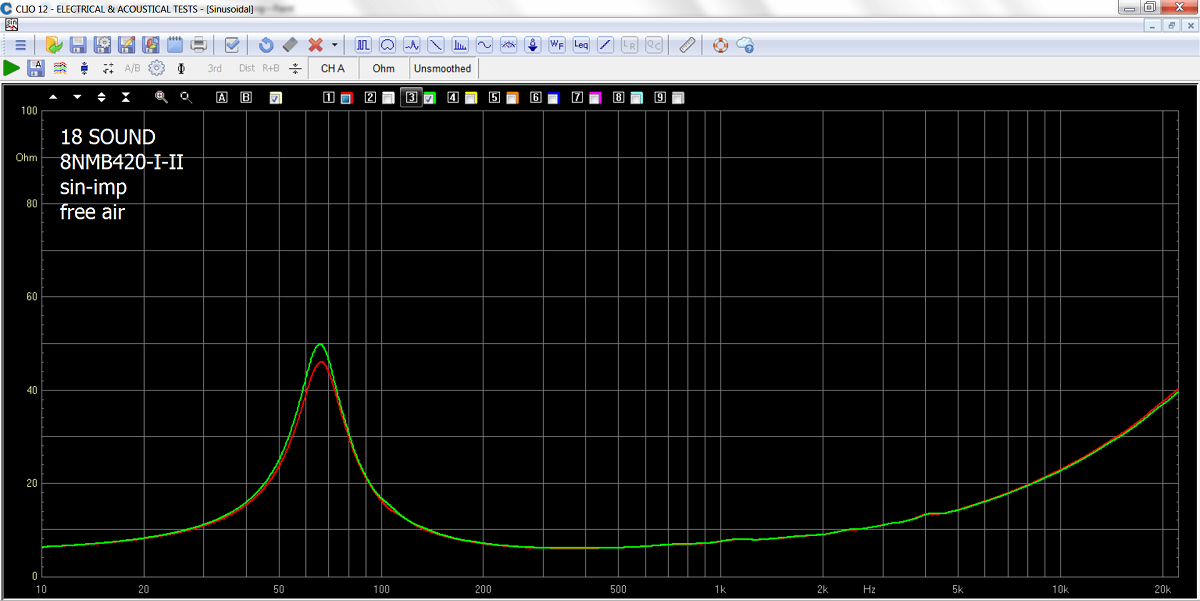
Free air impedance from the two drivers. Very smooth.
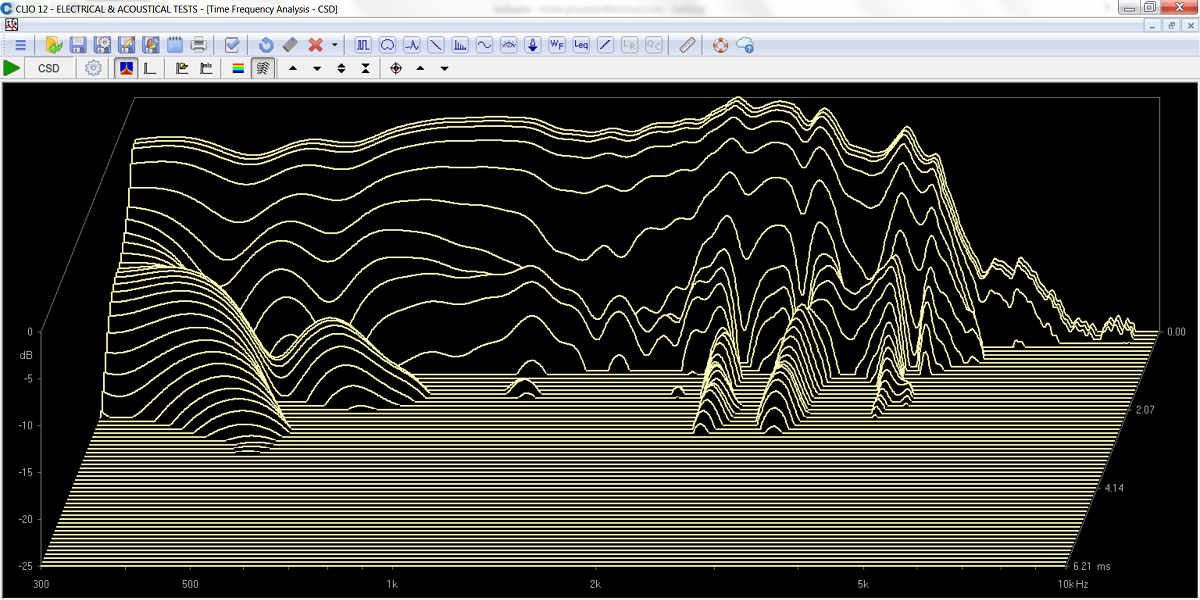
As expected, a nice and clean waterfall plot.
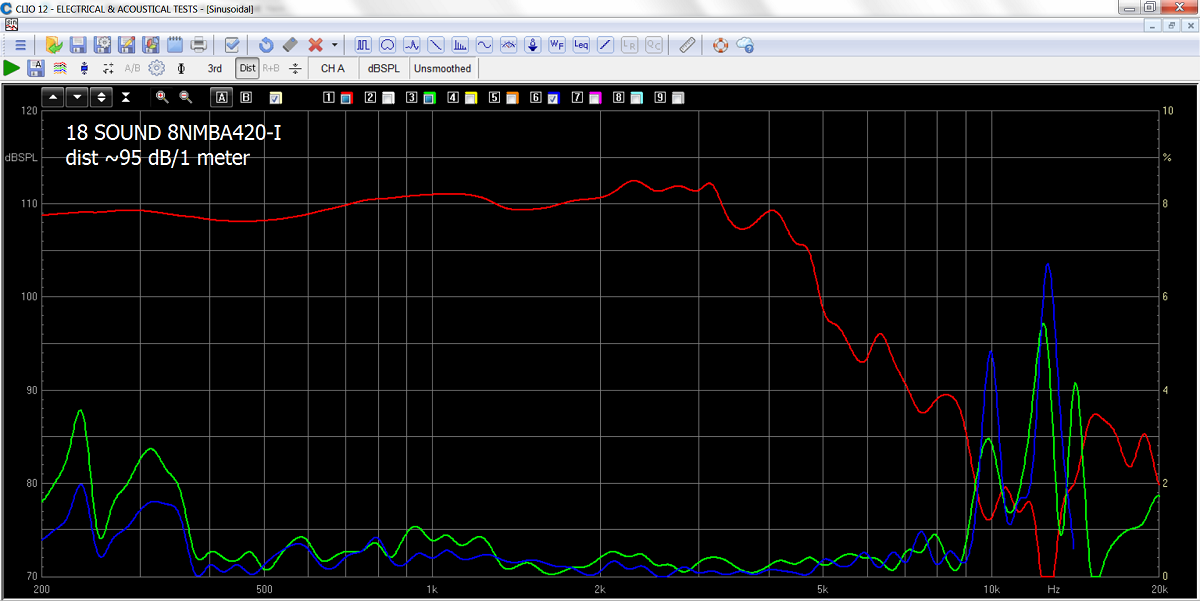
Distortion for unit I is very low in all of the intended working range.
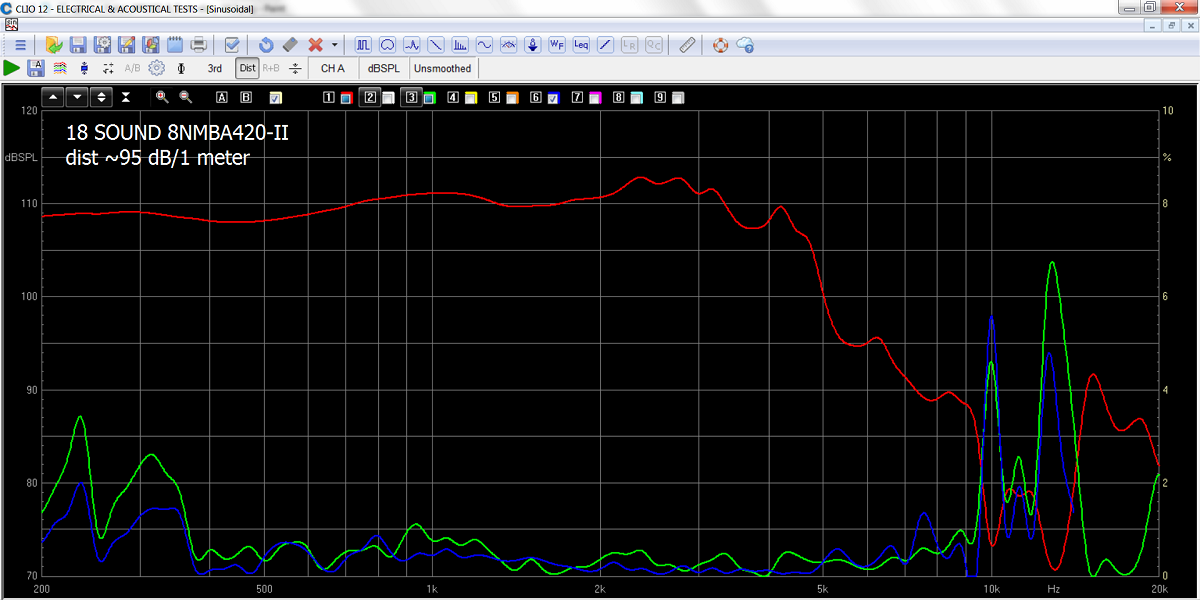
Distortion for unit II, same picture as for unit I.
LISTENING TESTS
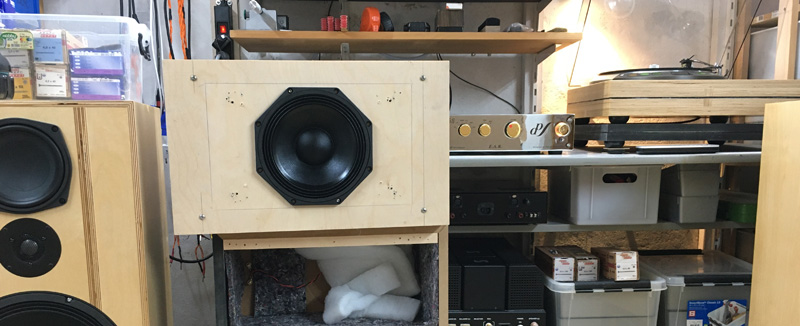
For listening tests I placed the drivers in a well-damped 33 litre closed enclosure and for some of the drivers I added a 0.27-0.47 mH coil in series just to flatten the response a bit in order to listen to something reasonably linear. For the test I use music I know very, very well and listen for clarity of presentation, harshness in lower treble, dynamics, etc. I know the smoothness of a clarinet and listen for any colouration of the sound. I listen for the dynamics of a drum set, rimshots, etc. I listen for quite some time while walking the workshop to get an impression of dispersion, etc.
I have to say this listening test came as a surprise. I was
expecting some of the drivers to have a somewhat harsh lower treble due
to peaks and dips in the 3-7 kHz range. Not the case! Not at all.
The B&C 6PEV-13-8 stood out due to size. How much low-end a driver can
manage makes a difference on the overall perception, but this 6" driver did very well indeed and
could well have been a candidate for the Faital-3WC, here standing next to the test
set-up.
The 18 SOUND 6ND410 didn't sound bad either, but this driver measures
too bad for my taste.
I was expecting the 8PR200 to have some issues. Well, it just didn't! Smooth and
full-bodied and nothing that stood out. So was the 16 Ohm 8PR210 - and I
think it's the first time I have used my 16 Ohms tabs on my EAR-861
power amp.
I find these two drivers interesting as they on the surface are quite
similar except for magnet, but if we place them side by side, we notice the cone shape is
different, the 8PR200 having a deeper cone and a smaller dust cap
(70 mm vs 75 mm for PR210). The more shallow cone of the 8PR210 and
wider dust cap makes it a more dedicated midrange driver and also the
higher Fs adds to this classification. I wonder what the 8PR200 was
really meant for, as it given its low Fs would do for a small 2-way
monitor - or even play quite some bass from a TQWT design. It's a driver
that makes you thinking.
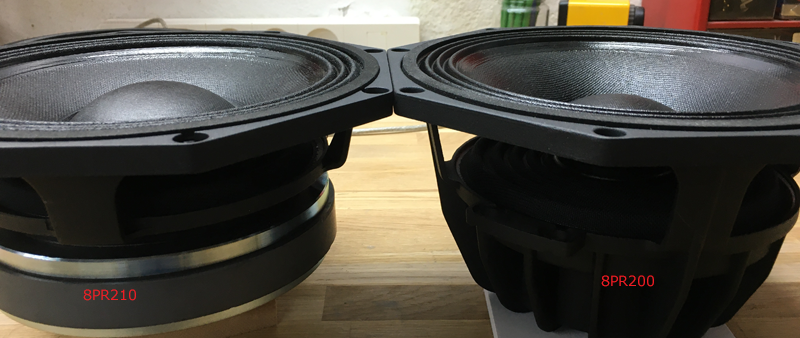
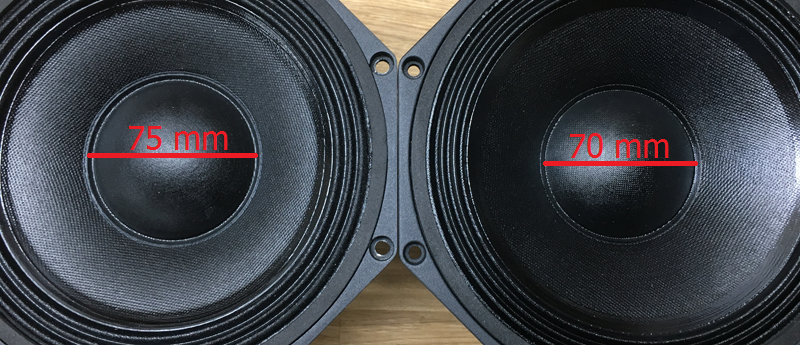
Anyway, I like the sound of both and they're candidates for future constructions.
The B&C 8PE21 certainly is the most efficient of the lot and appears the most dynamic, but this can come down to efficiency. Smooth on the ear as expected from its inherent smooth frequency response, but as said, others that may display a more rugged profile, did very, very well too.
The 18 SOUND 8NMB420 was expected to deliver a smooth response and certainly did. An easy driver, like the 8PE21, when it comes to crossovers and overall implementation and knowing and liking its larger sibling, the 10NW650 from TL-1, I'm not surprised. 18 SOUND seems to know what they're doing and scores high on all parametres. Here an excerpt from the datasheet:

Very few manufacturers would go this far and use a voice coil wound on both sides of the voice coil bobbin. I'm impressed. Qm = 4, which goes for the majority of the drivers tested here except for the Faital 8PR200, which make a whopping 9.4, but high mechanic Q isn't everything as long as we exceed 3-4 - to my experience.
Picking the right driver for this project became more difficult than
anticipated as they all seems suitable based on measuring performance
and listening test. Some of the drivers have significant higher
distortion than others, but I found no correlation to performance in
these measurements, nor the ragged roll-off profile of some of the
drivers, the latter quite a surprise.
Simulation of the drivers in the intended 3-way set-up certainly is
easier for some than for others and here the 18 SOUND and B&C 8" made
the simplest crossover, but simplicity doesn't necessarily equal better
sound.
The final test will be setting them up, all of them,
in the 3-way to come and hear which makes the best marriage of all. I'm
afraid it will be a matter of taste and not quality. Fortunately the
bass and tweeter crossovers can stay the same for testing the various
midrange drivers, at least initially. In the final fine-tuning we may
further improve driver integration by altering the bass low-pass filter
and tweeter high-pass filter.
18 SOUND 8NMB420 was the final choice for the
Faital 3WC-15 speaker construction.